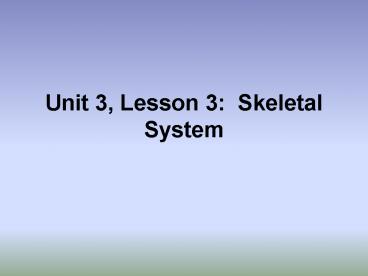Unit 3, Lesson 3: Skeletal System - PowerPoint PPT Presentation
1 / 15
Title:
Unit 3, Lesson 3: Skeletal System
Description:
Unit 3, Lesson 3: Skeletal System Daily Food for Thought * What does bone do? Learning Targets * I can categorize bones and assess their functions. – PowerPoint PPT presentation
Number of Views:129
Avg rating:3.0/5.0
Title: Unit 3, Lesson 3: Skeletal System
1
Unit 3, Lesson 3 Skeletal System
2
Daily Food for Thought
What does bone do?
3
Learning Targets
I can categorize bones and assess their functions.
4
In table pairs, list all the bones in the front
leg of a cow.
5
What is the function of bone?
- Bone helps with
- Movement
- Support
- Protection
6
What is bone made of?
- Bone is comprised of
- 26 minerals (mostly calcium phosphate and
calcium carbonate) - 50 is water
- 4 is fat
- 20 is protein
- Bone requires adequate
- amounts of vitamins and
- minerals in the ration.
7
Important Terms Related to the Skeleton
- Skeletons can be divided into two sections, which
include - Axial SkeletonThese bones are on or close to the
midline axis of the body and include the skull,
vertebrae and ribs. - b. Appendicular skeletonThese bones project
from the body in the pectoral (front) and pelvic
(hind) limbs, and are connected to the body
through the bones of the girdles.
8
Other Important Terms, Con't.
- c. Jointspoints where two or more bones meet.
- d. LigamentTough band of connective tissue
connecting one bone to another.
9
Other Important Terms, Con't.
- e. TendonThick band of connective tissue that
attaches muscle to bone. - f. Compact Bonelayer of protective hard bone
tissue surrounding every bone - g. Spongy Bonesoft bone filled with many holes
and spaces surrounded by hard bone.
10
In table pairs, name one bone that fits into each
category previously listed.
11
Types of bones in the animal body
- Long Bones--They serve as support columns. They
assist the animal in body support, locomotion and
eating. Example Femur - Short Bones--They are shaped like a cube and are
located in complex joints, such as the knee and
hock. They diffuse concussion and diminish
friction. Example Hock - Flat Bones--They protect vital
- organs such as the brain, the
- heart, and the lungs. They are longer
- and wider than they are thick.
- Example Scapula
12
Types of bones in the animal body
- Pneumatic bones--they contain air spaces called
sinuses that are in contact with the atmosphere.
Example Frontal face bones. - Irregular Bones--important to the protection and
support of the central nervous system and are
points of some muscle attachment. Example
Vertebrae - Sesamoid Bones--they are flat and round. They
are located along the course of tendons. Example
Kneecap or patella
13
In table pairs, list one bone for each type of
bone (not the ones listed)
14
Unlabeled Horse Skeleton
15
Horse Skeleton































